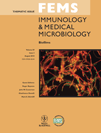Effects of clinical isolates of Pseudomonas aeruginosa on Staphylococcus epidermidis biofilm formation
Editor: Roger Bayston
Abstract
Pseudomonas aeruginosa is often found in chronic infections, including cystic fibrosis lung infections and those related to chronic wounds and venous ulcers. At the latter sites, P. aeruginosa can be isolated together with Staphylococcus epidermidis, and we have therefore explored the effect of clinical isolates and laboratory strains of P. aeruginosa strains on colonization by S. epidermidis in dual-species biofilms. Biofilm formation was assayed using 16S rRNA FISH and confocal laser scanning microscopy. Among the six P. aeruginosa strains tested, one particular strain, denoted 14:2, exerted a significant inhibitory effect, and even after 6 h, S. epidermidis levels in dual-species biofilms were reduced by >85% compared with those without P. aeruginosa. Interestingly, strain 14:2 was found to be negative for classical virulence determinants including pyocyanin, elastase and alkaline protease. Therefore, we suggest that less virulent phenotypes of P. aeruginosa, which may develop over time in chronic infections, could counteract colonization by S. epidermidis, ensuring persistence and dominance by P. aeruginosa in the host micro-habitat. Further studies are required to explain the inhibitory effect on S. epidermidis, although extracellular polysaccharides produced by P. aeruginosa might play a role in this phenomenon.




